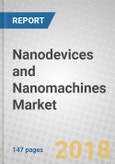The report covers all types of nanomechanical and molecular nanomachines in use or known to be under development as of early 2018, including:
- Electromechanical devices that interact with the environment on a nanoscale level to accomplish specific tasks or purposes.
- Electromechanical devices with outer dimensions measured in nanometers.
- Molecular machines that are not mechanical or electromechanical in nature but employ molecular-scale biological components that produce quasi-mechanical actions or outputs in response to specific stimuli.
- A pragmatic decision was made to exclude certain types of devices from the report that technically fit the definition of the term " nanotechnology." Nanoscale semiconductors are excluded, as they have been analyzed comprehensively elsewhere and would overwhelm other nanomachine technologies by their sheer volume.
The time frame for the analysis is the period from 2017 to 2028 to allow for the fact that many of the devices analyzed by the report are still in the research and development phase but could reach the commercial market by 2028. The market values estimated or imputed for various segments represent the direct cost to the user or investor. These values are expressed in 2017 dollars, and no attempt has been made to adjust them for inflation.
The Report Includes:
- 33 tables
- A detailed overview of the global market for nanodevices and nanomachines within the nanotechnology industry
- Analyses of global market trends with data from 2017, estimates for 2018, and projections of compound annual growth rates (CAGRs) from 2018 through 2023 and 2023 through 2028
- Characterization and quantification of global market for nanodevices and nanomachines by type, application, technology, end user, and geographical region
- Information on electromechanical devices that interact with the environment on a nanoscale level to accomplish specific tasks or purposes
- Critical analysis of the changing regulatory environment with focus on political landscape and legal and regulatory dimensions
- A relevant patent analysis, and number of U.S. patents issued for nanomachine-related developments
- Company profiles of major players in the market, including ExxonMobil, Hummingbird Scientific LLC, JEOL Ltd., Lockheed Martin, Oxford Instruments and Thermo Fisher Scientific
Membership Price:
Contact us for membership pricing.
Table of Contents
Executive Summary
If nanomachines are narrowly defined as nanoscale (i.e., measuring 100 nanometers or less) mechanical, electromechanical or biologically-based devices, the near-term market for these devices is practically non-existent. Most of these devices are still at the early research and development stage, and it is uncertain how many will even make it to market by 2028. Therefore, this report extends its definition of the term “nanomachines” to include most types of electromechanical devices that interact with their environments on a nanoscale level to accomplish specific tasks or purposes.
At the sub-100-nanometer scale, the properties that characterize larger systems do not necessarily apply to nanoscale devices or the materials used to fabricate them. As mechanisms get smaller, the relative amount of interfacial area becomes much larger and surface forces become stronger. The combination of friction and irreversible sticking, called “stiction,” can cause nanoscale devices to fail. One of the challenges to making nanorobots work well is getting them to move through body fluids, which are like molasses to something as small as a nanorobot. Researchers are working on solutions to these and other challenges, but the long-term outlook is promising.
Reasons for Doing This Study:
From a 2018 perspective, it is impossible to foresee all of the impacts of nanomachines on science, medicine and industry, but the impacts are likely be tremendous. It would be surprising if nanomachines were not surrounded by a great deal of hype considering their potential. This hype includes both rosy predictions of the ways in which nanomachines could serve mankind, as well as apocalyptic scenarios, such as the one in which out-of-control self-replicating robots consume all the biomass on Earth while building more of themselves.
Even the positive hype carries the risk of a backlash, as it can create unrealistic expectations for nanotechnology. People tend to withdraw when expectations are not met, or worse, they turn oppositional. As a result, legitimate nanomachine technologies and applications are hurt, along with the pseudos, as funding and markets dry up.
Companies Mentioned
- AB Sciex
- Alio Industries
- Altair Nanotechnologies
- Applied Nanotech Holdings Inc.
- Boeing Company
- Bruker Axs
- Colossal Storage Corp.
- Dionex Corp.
- Discovery Technology International, Inc.
- Eksigent Technologies Llc
- Ev Group
- Exxonmobil
- Halo Labs Inc.
- Hitachi High Technologies Corp.
- Hummingbird Scientific Llc
- Imina Technologies Sa
- Innopsys
- International Business Machines
- Inanobio
- Integrated Device Technology Inc.
- Jeol Ltd.
- Kleindiek Nanotechnik Gmbh
- Klocke Nanotechnik
- Lockheed Martin
- Mad City Labs Inc.
- Microfluidics Corp.
- Mitre Corporation
- Molecular Imprints
- Nanolike
- Nanomix
- Nanonex
- Nanonics Imaging Ltd.
- Nanosensors
- Nanosurf Ag
- Nil Technology Aps
- Npoint, Inc.
- Obducat
- Oxford Instruments
- Park Systems Corp.
- Philips Electronics
- Physik Instrumente Gmbh & Co. Kg
- Rave Llc
- Shimadzu Corp.
- Smaract Gmbh
- Smart Equipment Technology
- Sony Corp.
- Suss Microtec
- Tescan Orsay Holding A.S.
- Thermo Fisher Scientific
- Vista Therapeutics Inc.
- Xidex Corp.
- Zyvex Instruments Llc








